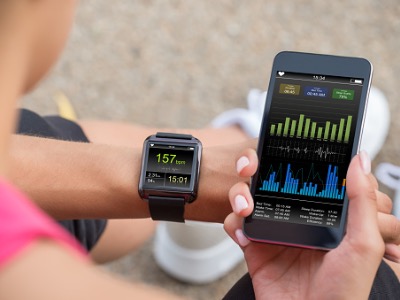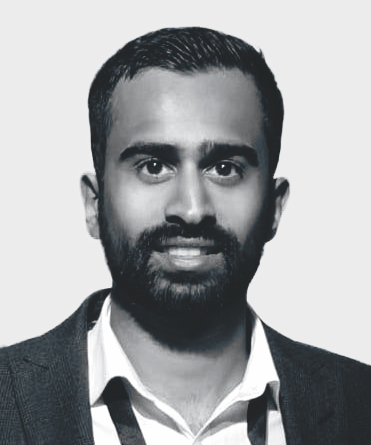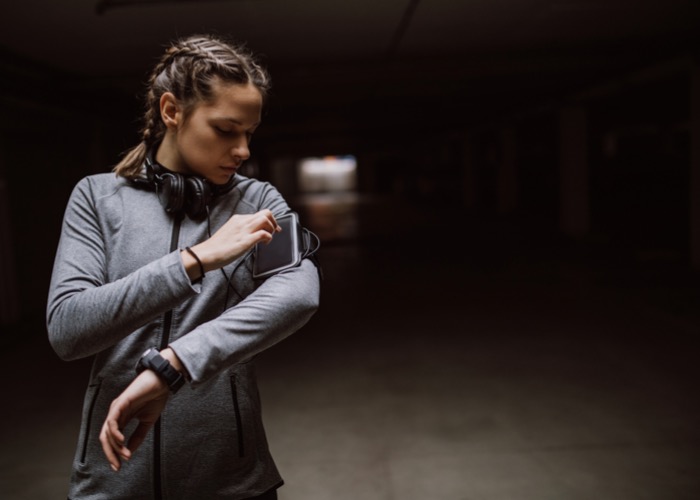Wear necessities
In OTC
Follow this topic
Bookmark
Record learning outcomes
According to the PAGB report Self Care and Technology (August 2019), over the next five years it is predicted that artificial intelligence and remote monitoring will be the most disruptive forces in health apps and wearables. There are now fitness trackers that check blood pressure, heart rate and sleep patterns, but eventually consumer devices could measure a wider range of biometric data and use this data to provide effective solutions for health problems. With more people using on-the-go digital technology on a daily basis, the NHS wants consumer wearables to play an increasing role in the future management of long-term conditions.
In November 2018, the NHS Long Term Plan announced that “patients with type 1 diabetes would benefit from life-changing flash glucose monitors (the Freestyle Libre) from April 2019”. Freestyle Libre is a wearable sensor about the size of a £2 coin that sticks to the arm and relays glucose levels to an e-reader device or a smartphone app. Rather than measuring blood glucose levels, it measures the amount of sugar in the interstitial fluid under the skin. The sensor measures glucose levels continuously throughout the day.
It is hoped that if CCGs follow the NHS guidance correctly, access to the technology should increase to at least 20 to 25 per cent (from only 3 to 5 per cent).
Taking a holistic approach
Graham Phillips, director and superintendent pharmacist of Manor Pharmacy Group, offers the Freestyle Libre privately to pharmacy customers to reduce their sugar intake and improve their lifestyle as part of his ProLongevity programme. “The programme has been running for about two years and focuses on prevention, rather than treatment,” he says. “It takes a holistic approach, getting to the root causes of metabolic syndrome and hyperinsulinaemia, such as a diet high in sugar, carbohydrates and processed foods. It began as part of the Manor Pharmacy service, but is now a separate service with its own website.”
Customers first have a discussion with the pharmacist about their lifestyle and provide background data, such as height, weight, waist size and blood pressure. They are then given the Freestyle Libre to monitor their blood sugar levels, and they keep a record of everything they eat and drink. A smartphone app shows the correlations between the food they eat and any spikes in blood sugar levels.
About 100 patients have enrolled on the programme so far, and feedback has been positive. “Using Freestyle has been a game changer for me,” says one customer. “The ability to test my blood sugar constantly has resulted in a new level of self-accountability. Knowing that eating the right food can keep my sugars level and actually seeing that happen in real time is a great motivator. It has now been just over two months since I started ProLongevity. My sugar levels are under 8mmol/L – it was about 23mmol/L when I started. My 30 day average reading is 5.8mmol/L. I have lost nearly 20lb in the same period. I follow a very low carb diet and keep my carbs under 20g. And I really enjoy what I eat.”
Clinical approach
A Social Market Foundation report in May 2019, National Health Servers: Delivering Digital Health for All, highlighted the role that wearable technology can play in tracking, monitoring and treating patients. Wearables that continually monitor patient physiology, such as blood glucose, blood pressure, temperature and heart rate, are already being tested in some clinical settings. NTT Data UK has partnered with Great Ormond Street Hospital, which uses its Hitoe wearable technology to give doctors access to health analytics about patients at all times. This enables medics to pull up records within seconds, have all the relevant information to hand and make informed decisions about a patient’s health.
“Wearable tech is capable of revolutionising healthcare and, in more recent years, innovations in augmented realities, AI and smart fabrics have converged with genuine societal needs to create more compelling solutions,” says Tom Winstanley, head of innovation at NTT Data UK. “With ‘tech for good’ becoming its own industry, there is an increased demand for purpose in technology. The practical implications of wearable technology can now have genuine health benefits. With its ability to monitor heart rate, track biometric information and detect falls, NTT’s smart fabric, Hitoe, is an example of this.”
Wearables are already being used to manage certain conditions, including chronic pain and depression. Cefaly is an easy-to-use handheld gadget. A self-adhesive electrode is placed on the forehead and then low levels of electric current are used to stimulate trigeminal nerve endings and disrupt pain signals. In 2016 NICE advised that Cefaly can be used safely in the NHS to treat and prevent migraine.
 Flow recently launched a brain stimulation headset and therapy app for depression. The headset uses transcranial direct current stimulation, a form of neurostimulation that delivers constant, low direct current via electrodes on the head. In Europe, Flow is classified as a Class IIa medical device and was certified by the BSI’s Netherlands-notified body. Randomised controlled trials showed that brain stimulation of the type used in the Flow headset had a similar impact to antidepressants, but with fewer and less severe side effects. The company is in talks with the NHS to have its brain stimulation headset available on prescription.
Flow recently launched a brain stimulation headset and therapy app for depression. The headset uses transcranial direct current stimulation, a form of neurostimulation that delivers constant, low direct current via electrodes on the head. In Europe, Flow is classified as a Class IIa medical device and was certified by the BSI’s Netherlands-notified body. Randomised controlled trials showed that brain stimulation of the type used in the Flow headset had a similar impact to antidepressants, but with fewer and less severe side effects. The company is in talks with the NHS to have its brain stimulation headset available on prescription.
The future for high-tech developments
This year’s Global Innovation and New Technology (GIANT)Health Event took place on 15 and 16 October at Chelsea Football Club Stadium. P3pharmacy went along to listen to the ‘Wearables and Beyond’ day of talks, which was curated by Thrive Wearables and introduced by Dr Jacob Skinner, the company’s CEO.
Keith Errey, co-founder and CEO of Isansys Lifecare, discussed wearables in the acute sector and focused on how continuous monitoring may help to reduce iatrogenic deaths (deaths caused by inadvertent harm during medical treatment or diagnostics). These deaths may be a consequence of increased demands on healthcare, including cuts in budgets and staff shortages, which lead to reduced efficiency. “There’s no magic bullet, but it will help if patients are being monitored at all times,” he said. Isansys Lifecare, which was established in 2010, offers wireless patient monitoring systems.
Charles Nduka, co-founder and chief scientist at Brighton-based Emteq, spoke about the company’s EmteqVR device, which uses virtual reality and AI to assess facial expressions as people interact with the world around them. Mr Nduka, whose background is in facial deformities and facial paralysis, developed EmteqVR to measure facial gestures through muscle activity and biometric responses. He believes the EmteqVR device could eventually use different virtual reality scenarios to manage severe anxiety disorders and phobias.
Ian Yeels from Equivital discussed how body-worn sensors can be used to monitor vital signs continuously and remotely in all environments. Clinical healthcare applications include sleep, exercise and mental health, but there are also military and industrial applications. The Black Ghost monitoring system, for example, is being used in personal protection equipment clothing to assess the risk of heat strain, especially when people are working on their own or in the field in remote environments.
Stefan Chmelik, CEO at Bioself Techology, discussed the “power of the passive”, meditation for those who don’t have the time to learn or practise the techniques. Bioself Technology has developed Sensate, a wearable device that is aimed at the consumer rather than the medical market. This small device looks like a stone and is placed on the chest while the user is lying down. It uses vibration to stimulate the vagus nerve, which is scientifically proven to lower stress levels. Sensate could be used in chronic pain and anxiety disorders.
So what is the future of wearable devices? During a panel discussion on human sensing innovations, Dr Skinner said he believed wearable technology could eventually be used to predict falls or spot diseases very early on. Dr Leon Eisen, CEO of Oxitone Medical, said he suspected there would be further advancements in another 10 years. He believes that wearables are the intermediate step to implantables, which should need little user input once they are in place. Mr Chmelik went one step further. He believes that eventually there will be “integrated sensors” that don’t need to be implanted under the skin. Instead, these could be grafted or even tattooed onto the body.
Exhibitors at the event included Acute Technology’s My Medication Monitor, a prototype Bluetooth sensor that slots into existing medicine packets to record whenever a patient removes the blister pack to take a pill. It is aimed at improving medication compliance. Then there was Lifecast Body Simulation, which produces highly accurate life-like “bodies” that can be used in medical simulation and education, including first aid training. What we would have considered to be science fiction just a decade ago is now fast becoming a reality.
P3pharmacy category panel
 Lila Thakerar, Shaftesbury Pharmacy, Harrow
Lila Thakerar, Shaftesbury Pharmacy, Harrow
“We get a lot of queries about BP machines, so we do try to pass on deals to our customers where we can. Omron is one of our popular brands, though generic devices sell well too. Medicare also sells well. Customers want something digital that’s easy to use. Glucose monitoring is also a fast-growing area. Gluco RX Nexus is our best seller. The trend is for patients to come to their pharmacy for these devices now, so it’s important to stock different brands and price ranges.”
 Mital Thakrar, Well Pharmacy, Birmingham
Mital Thakrar, Well Pharmacy, Birmingham
“It is becoming increasingly common to discuss smart technology with patients. For example, the number of calories burnt, steps taken or distance covered can be useful. Pharmacy teams need to know what kind of conversations to have with patients, what questions to ask and how to look for trends in the information they are presenting. In a clinical review with patients, utilising the data available from these devices can allow us to set challenges to improve overall health.”
 Melissa Liew, Ellacombe Pharmacy, South Gloucestershire
Melissa Liew, Ellacombe Pharmacy, South Gloucestershire
“There has been an increasing trend of patients taking their health into their own hands. Smart and wearable health devices empower people with data about their health. Patients should be advised to select approved medical apps that carry a CE mark, which when used in accordance with the instructions, are safe to use. Some patients may need help and support with health tracking. Gathering any kind of information is only helpful if it can be interpreted correctly.”

